The Bagge=pipe Way
The prize-winning piece played by Paul Roberts at this year’s competition, which he called ‘The Hunting of the Fox’ was drawn from two 17th century manuscripts. Here we take a closer look at these remarkable sources.
The Hunting of the Fox’ was, unlikely as it may seem, a compilation of music from two manuscripts for the bass viol or viola-de gamba. The first is anonymous and is held in the Henry Watson Music Library at Manchester Public Library, and is known accordingly as the ‘Manchester Manuscript’.1 It appears to date from somewhere between 1640 and 1660. The second manuscript is in the Chester Records Office and is the work of Sir Peter Leycester, antiquarian and Lord Lieutenant of Cheshire.2 His work is in the form of ‘A Booke of Lessons for the Lyra=viole’ and carries the date 1659. These manuscripts come from an area of the North-West of England well-known for its historical links with bagpiping and their compilers may have been known to each other.
What makes these manuscripts of immense value to bagpipers interested in early sources of pipe music is that they are both divided into sections categorised by the manner in which the viol is tuned. The bass viol is a fretted instrument with six strings which can be set in a variety of tunings; the Leycester manuscript has one tuning labeled ‘Bagge=pipe way’ and this section contains eight tunes plus what looks like a brief exercise. The Manchester manuscript has two tunings, one labeled ‘lancashire pipes’ (‘the seventh tuninge’‘ and the other ‘Bag=pipes’ (‘the eighthe tuninge’) which between them contain eight tunes, including one titled ‘bag=pipes’ and another ‘Lanca=shire pipes’, the tune which formed the basis of Paul’s interpretation. Not only does all the melodic music in these sections of both manuscripts stay within the nine-note range, but a good deal of it is Scottish music, and some of these tunes were popular enough to appear in several manuscripts, for various instruments, from the period around the beginning of the 17th century.

‘Bag=pipes’ from the Manchester manuscript
[the tune is one used several times by William Byrd]
The music for ‘Lancashire Pipes’ and the remainder of the bagpipe music in the Manchester MS was printed (for pipes in D) in my Robin with the Bagpipe.3 I have appended it to this article transposed for pipes in ‘A’. Of the music in the Leycester MS, the jygge, the hornpipe, the canary and the Hunts Up, were transcribed in The Day it Daws; the other tunes have not been published hitherto, as far as I am aware. This ‘horne=pipe’, first published by John Ward in his seminal essay ‘The Lancashire Hornpipe’4 is clearly the Manchester Manuscript’s ‘Lancashire pipes’ material in a different working. It is titled ‘A Horne=pipe called the Bag=pipe Horne=pipe other=wise The Knave of Clubs’. In Paul Roberts’ words this piece ‘first forms an extension of the 3/2 hornpipe in the Manchester MS, then links this melodically to the opening march, before finally dissolving into a sort of jazz-like riff.’ Paul used this material to extend the Manchester MS music into his border-pipe version of the Fox Chase. His piece began with a tune from the Manchester MS titled ‘A Pointe, or preludium to be playde before the Lancashire pipes’, and finished with the music labeled ‘Upstroke’ in the manuscript. What Paul was unaware of at the time is that the Leycester MS also contains an ‘Upstroke to be played after the hornpipe’, the content of which is quite different to that of the Manchester MS. Whatever these manuscripts meant by the term ‘Upstroke’ it is intriguing to note that the word appears in an identical context in a contemporary poem written by William Blundell of Crosby, Lancashire, a noted cavalier and Royalist [as indeed was Leycester and, it seems, most of the known musicians of the period ]. The poem is titled ‘A country song remembering the harmless mirth of Lancashire in peaceable times, to the tune of Roger o’ Coverley’.5 It describes a country fair to which come ‘the lads’ from surrounding villages who engage in a competition of hornpipe dancing, each to the sound of their bagpiper’s music. In addition to naming two pipers and several dance tunes of the period, the poem, the main part of which is in 9/4 rhythm, finishes with a section set to ‘the Upstroke’, in 6/4.6
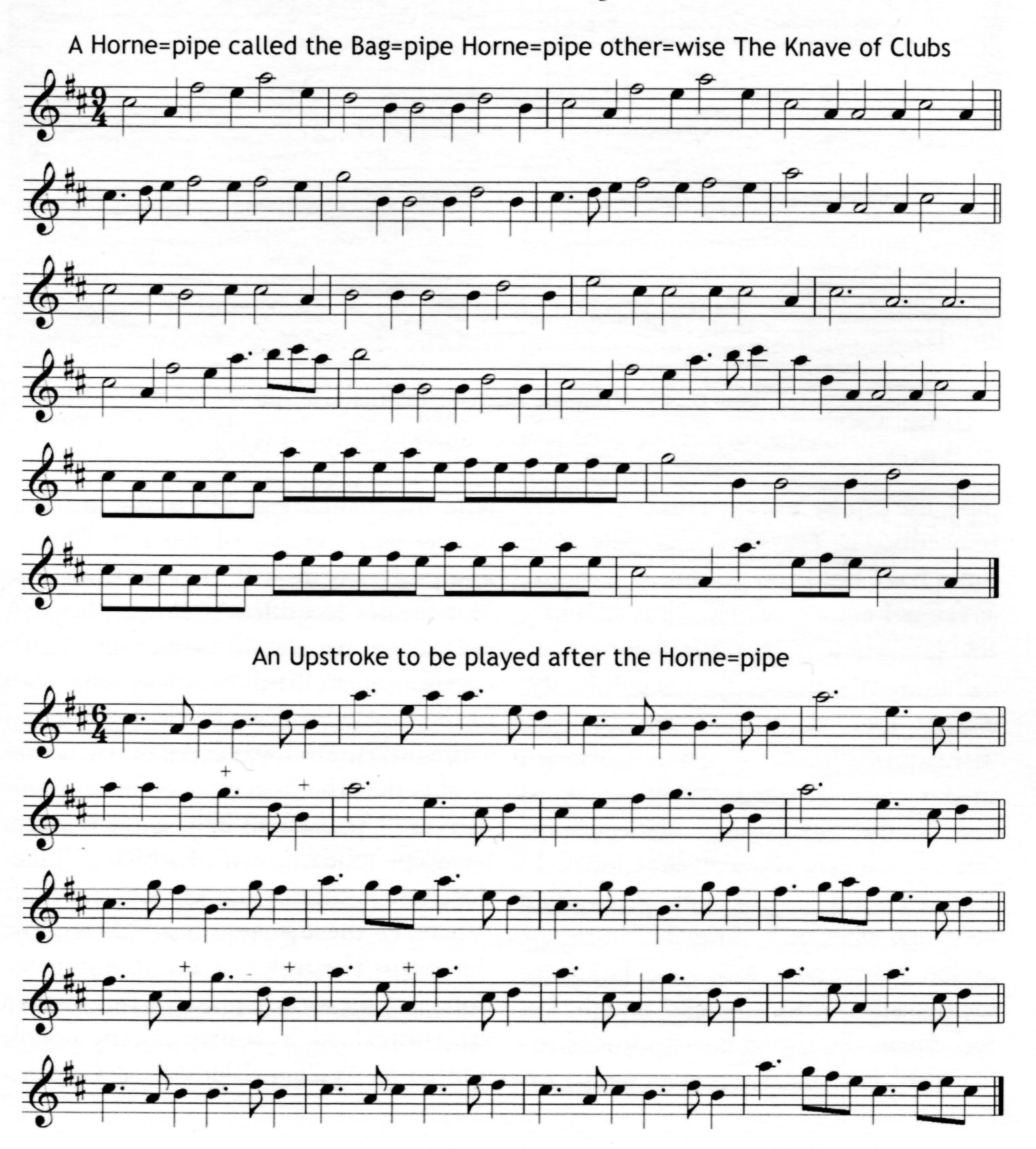
The manuscript contains two tunes with clear Scottish connections. The first is the ‘Scottish Jygge’ which was discussed in The Day it Daws.7 The second is a setting of the old tune of ‘Kate o’ Bardie’; though the Leycester setting is untitled, the same tune, in a slightly simpler setting, appears in the Manchester Manuscript, where it is named. Another variety of the tune appears in the 1630 Skene Manuscript.
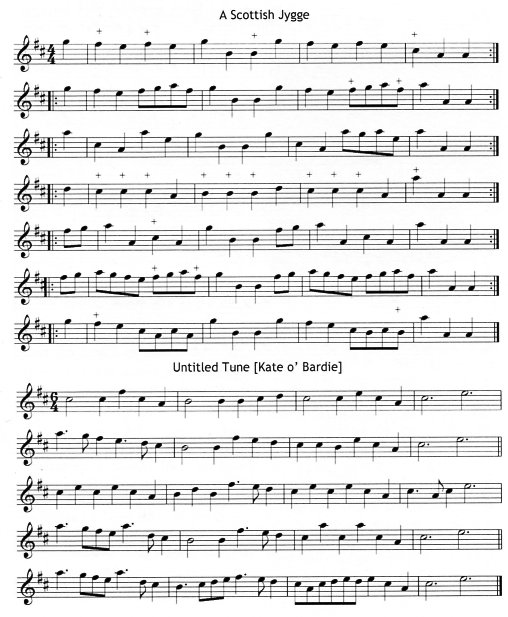
The manuscript contains two tunes with clear Scottish connections. The first is the ‘Scottish Jygge’ which was discussed in The Day it Daws.7 The second is a setting of the old tune of ‘Kate o’ Bardie’; though the Leycester setting is untitled, the same tune, in a slightly simpler setting, appears in the Manchester Manuscript, where it is named. Another variety of the tune appears in the 1630 Skene Manuscript.
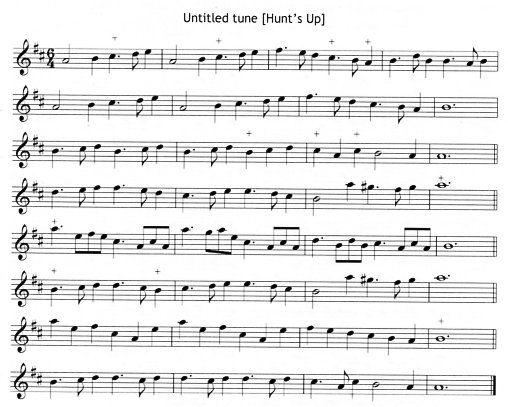
The manuscript also includes a setting of the ‘Canaries’, clearly a popular dance in early 17th century Scotland; there are two settings in the Straloch MS (1627) and one in the Skene MS (c.1630).7

The following tune is untitled in the MS. It may be simply an exercise; if so, it is one with decidedly ‘Lowland’ characteristics, and might even be considered as another ‘Scottish Jygge’.
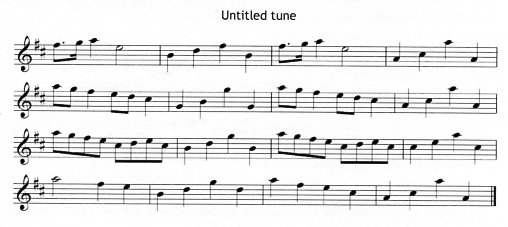
The remaining tune in this collection of ‘bagpipe’ music is something quite different; it has the feeling of a dance from the Playford collections (the first of which was published in 1651, when the Leycester MS was still being prepared). Although Playford published a good deal of Scottish music, this is most likely an English song. Its first two bars are derived from Praetorius’ ‘La Bourre’.

The following tunes are transcribed from the Manchester Manuscript. Most of these are very simple settings; here is the old tune of Kate of Bardie [from which we can recognise the untitled tune above]

Another Scottish tune in the Manchester Manuscript is titled ‘Pigges of Rumsey’, a delightful reworking of the tune’s original title ‘Peggy Ramsay’ [another fine example of the fact that if you want your tune to remain in the tradition for hundreds of year some filthy words set to it are a great help].

Two more simple tunes, the first untitled, the second with the title often attached in these manuscripts to such melodies, ‘A Toye’,.
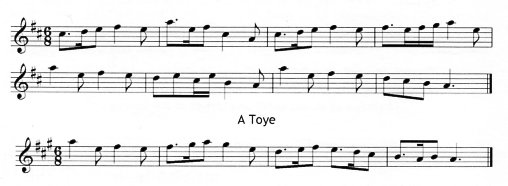
On the following page are the three pieces which, together with the ‘Bag=pipe Horne=pipe’ above, formed the basis of Paul’s piece. They come from the section of the Manchester Manuscript labeled ‘The seventh tuninge Lanca=shire pipes’. The first is titled ‘A pointe or preludium to be played before the Lanca=shire pipes’, the second is ‘Lanca=shire pipes’ itself and the last, which in the manuscript follows on continuously from this, is marked ‘upstroke’. A facsimile of the manuscript page containing the end of the Lancashire pipes with the upstroke, together with Kate of Bardie and The Pigges of Rumsey is included on page 15. A transcription of the magnificent 20-strain setting of ‘Put up they Dagger Jamie’ which appears in the manuscript will be available on the website shortly, along with Playford’s ‘bagpipe music from The Division Viol and other related material.
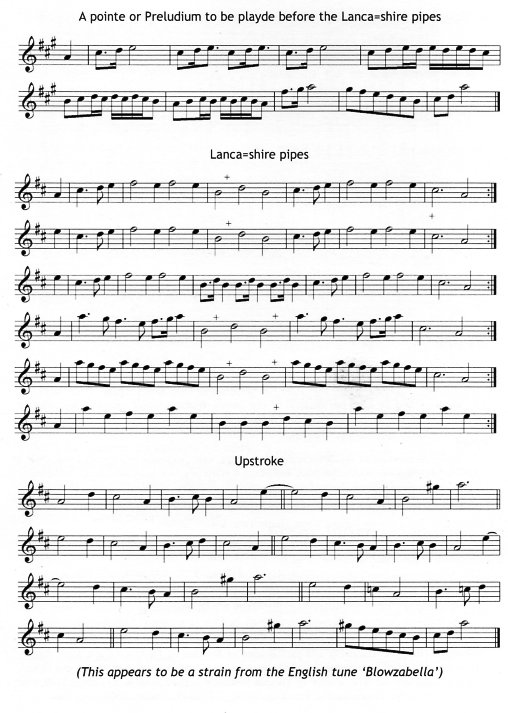

The second page of the ‘Seventh tuninge Lanca=shire pipes’ section of
the Manchester 'Viol Da Gamba Book', BRMs832Vu51
(Image provided by kind permission of the Henry Watson Music Library, Manchester Library and Information Service)
Notes
1. The complete contents of the ‘Manchester Manuscript’ were published by Peacock Press, 2003 as The Manchester Gamba Book. Containing 246 items, it is the largest known manuscript collection for the instrument. The majority of the contents are sarabandes, corantos, almains, preludes etc.
2. A Booke of Lessons for the Lyro=Viole, Chester Records Office, GB-CHEr DLT/B 31
3. Stewart, P., Robin with the Bagpipe, White House Tune Books , 2001
4. Ward, John M., ‘The Lancashire Hornpipe’, in Essays in Musicology - A Tribute to Alvin Johnson, A.M.S., 1990 pp. 140-173
5. Blundell’s poem was published in Crosby Records: A Cavalier’s Notebook, by Rev. T Ellison Gibson available on line, p.234. http://www.archive.org/stream/crosbyrecordscav00blunuoft/ crosbyrecordscav00blunuoft_djvu.txt. [retrieved 12/05/2011]
6. For the tunes mentioned by Blundell see Stewart, P., Three Extraordinary Collections, Hornpipe Music 2007 p.97. This essay is now available on the lbps website from the Resources page.
7. For other settings of ‘Hunts Up’ and the Canaries see Stewart, P., The Day it Daws, White House Tune Books, 2005. The ‘Scottish Jygge’ also appears, along with a Hunts Up, copied in a rather illiterate hand into the ‘Tokyo copy’ of Thomas Robinson’s New Lessons for the Cithern, 1609, available online at http://nanki-ml.dmc.keio.ac.jp/M-06_072_R044/content/0008_large.html.
